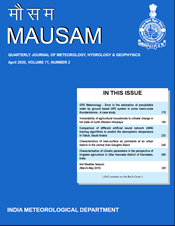Vulnerability of agricultural households to climate change in hill state of north Western Himalaya
DOI:
https://doi.org/10.54302/mausam.v71i2.19Abstract
In the present study, vulnerability level of individual farming households to climate change is examined in Himachal Pradesh, North-western state of India. Principal Component Analysis (PCA) was used to develop vulnerability index for individual household. Mean household vulnerability index in the study area was 0.27. The farming households from Kullu district were the most vulnerable (5.94) while those from Hamirpur district were least vulnerable (-3.37). The study successfully identified the regional sources of vulnerability and prioritises the districts for adaptation planning. Implication of the study results lays with the policy makers in formulating region specific and targeted climate adaptation policies that foster asset building so as to reduce vulnerability and build long-term resilience to climate change.
Downloads
Published
How to Cite
Issue
Section
License
Copyright (c) 2021 MAUSAM

This work is licensed under a Creative Commons Attribution-NonCommercial 4.0 International License.
All articles published by MAUSAM are licensed under the Creative Commons Attribution 4.0 International License. This permits anyone.
Anyone is free:
- To Share - to copy, distribute and transmit the work
- To Remix - to adapt the work.
Under the following conditions:
- Share - copy and redistribute the material in any medium or format
- Adapt - remix, transform, and build upon the material for any purpose, even
commercially.



